|
Lewisia cotyledon,
by Susan
Tindall |
| |
 |
I remember the first time I saw Lewisia cotyledon, it was at an AGS Show in Greenmount College, more than 25
years ago, and I also remember remarking to the friend I was with ‘How can that be an alpine, it is too big and very gaudy?’ As you can gather this was my first AGS Show, and knew
very little about growing alpines, realising I had a lot to learn and I am still learning, and finding out that some alpines are very difficult to cultivate.
|
|
|
Within a few years I did put plants on the Show Benches, won a few prizes, took silver home occasionally from a show. I have to say I was pushed
into showing by the then Show Secretary a lady named Nan Toner, and as any one who knew this lady, if she asked you to do something you did it.
I cannot say that
I ever won a prize with a Lewisia cotyledon, but is was when I started showing I realised how difficult it is to achieve a first prize for
any plant not just Lewisia Cotyledon.
I have always enjoyed growing anything from seed, be it vegetables or trees, for my husband to plant in his garden. |
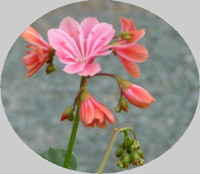 |
|
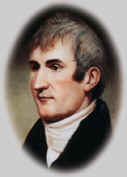 |
Lewisia cotyledon is an
alpine from the Rocky Mountains; an explorer named
Captain Meriwether Lewis in 1804 first discovered it,
the plant itself did not come into cultivation until
around 1860.
At around the time of my first show experiences, I drove
accompanied by my husband over to Scotland and visited
the famous Inshriach Nursery in Aviemore where John
Lawson produced Lewisia there by the thousands, it was
he who instructed me on how to sow the seed of Lewisia,
and it was from him I first obtained a few seed packets
of Lewisia.
|
|
Lewisia
seed will germinate at any time of year,
but I find I have best results sowing
the seed in the autumn when the
temperatures are not so high.
I always surface sow the seed, I use a
seed mixture, plus extra horticultural
grit, level off the compost and top
dress with layer of grit, then sparingly
sow the seed. Remember to write a label
with name and date of sowing. John
Lawson said he always covered his seeds
with newspaper, when the seeds have
germinated lift the paper off the young
seedling. I have to say I have never
done this, I find they germinate
perfectly well without the
covering of paper.
|
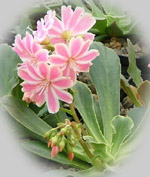 |
|
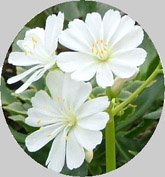 |
The seeds germinate very quickly even in winter, but I would wait until the spring before potting them up into 7cm pots. Lewisia have a fleshy
taproot and if damaged can cause botrytis, and nine times out of ten the plant will die, so take care when handling the seedlings, once potted up the
plants grow quite quickly, and the first year you will have flowers on your plants. Once you have selected the plants you plan to place on the show
benches, pot them into the next size up, do not over pot the plant, you will find if you do this the plant will only put on leaves and will not flower, be a
bit mean with the plant, do not over feed or over water.
I mix my own compost for Lewisia; I use peat free, plus one-third grit, and top-dress with grit a good layer, 1cm. Drainage is most important for
Lewisia, I cannot emphasize enough, too much fertilizer and water is death to the plant.
|
|
Collect seed from your own plants, the seed is easy to see, they are black and shiny. I have stored the seed in the freezer for years; the freezing
does not impair germination.
Lewisia grow on tops of mountains in bright sunshine on cliffs and ridges, but its roots plunge into cool substrate, usually on a northern exposure,
very difficult to copy this in cultivation, for plants destined to win prizes on the show benches, my
advice would be to grow them in clay long toms.
When growing Lewisia, and some may disagree, I always ease off watering in August, no
matter how high the temperature, and during the winter
period hardly water any at all. In winter the leaves of
my Lewisia are always a bit floppy; if the leaves turn orange due to over watering you may as
well put them on the compost heap at once, they will not come back to life again.
|
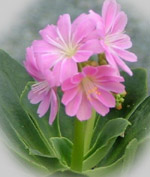 |
Many people I meet say they place their Lewisia on their sides so the water runs off, I have seen them growing in Bodnant on the famous Lewisia
wall, and I have to say I have never been able to achieve this result. If you wish to emulate Bodnant, with Lewisia cascading down a wall, the plants
must be small when placed in the wall.
Final thought, Lewisia are very flashy with many bright colours, I would recommend them as a patio plant for the summer, keep dead heading
through the summer, when winter comes along place the pot close to the house, or in a cool porch or a cold glass house, Lewisia often will flower
during the winter if under glass.
|
|
|
